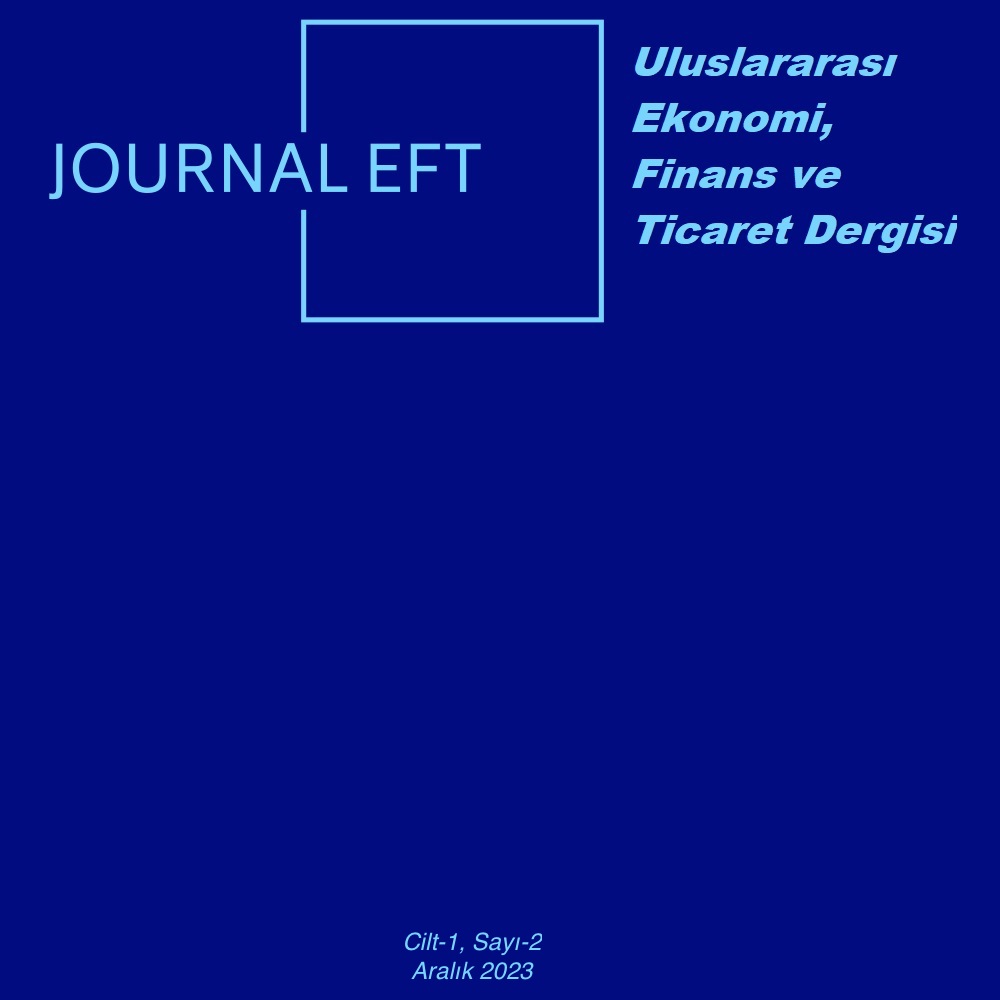INVESTIGATION OF INTEREST, INFLATION, EXCHANGE RATE RELATIONSHIP IN TURKISH ECONOMY WITH ARDL BOUNDARY TEST
Abstract
In this study, data from 2012-07 and 2022-09 periods were used to examine the short- and long-term relationship between interest rates, inflation and exchange rates in Turkey. ARDL bounds tests, cointegration analysis and Granger causality test were used for empirical analysis. In addition, the presence of structural breaks was investigated using the Zivot and Andrews unit root test. According to the test results of Zivot and Andrews, it was seen that all variables were unit rooted in level values and stationary in difference values. The results show that short and long-term increases in exchange rates have a positive and significant effect on interest rates, and it was determined that the increase in inflation did not have a significant effect on interest rates in the same periods. According to the results of the Granger causality test, it was observed that the exchange rate had a one-way effect on the interest rate, while the exchange rate and inflation had a bidirectional causality relationship.
References
Abu Asab, N., Cuestas, J. C., & Montagnoli, A. (2018). Inflation targeting or exchange rate targeting: Which framework supports the goal of price stability in emerging market economies? Plos one, 13(8), e0201798.
Amaefula, C. G. (2016). Long-run relationship between interest rate and inflation: Evidence from Nigeria. Journal of Economics and Finance, 7(3), 24-28.
Bayat, T. (2011). Türkiye’de fisher etkisinin geçerliliği: Doğrusal olmayan eşbütünleşme yaklaşimi. Erciyes Üniversitesi İktisadi ve İdari Bilimler Fakültesi Dergisi, 38, 47-60.
Baylan, m., & Pazarcı, P. (2020). Türkiye’de enflasyon faiz ilişkisi: Nedensellik analizi. İnsan ve Toplum Bilimleri Araştırmaları Dergisi, 9(1), 193-216.
Dickey, D. A., & Fuller, W. A. (1979). Distribution of the estimators for autoregressive time series with a unit root. Journal of the American statistical association, 74(366a), 427-431.
Dursun Güvenbaş, S. (2021). Faiz oranlarının enflasyon ve ekonomik faaliyetlere etkisi: Türkiye örneği.
Dutt, S. D., & Ghosh, D. (1995). The Fisher hypothesis: Examining the Canadian experience. Applied Economics, 27(11), 1025-1030.
Engle, R. F., & Granger, C. W. (1987). Co-integration and error correction: Representation, estimation, and testing. Econometrica: journal of the Econometric Society, 251-276.
Evren, S., & Mucuk, M. (2019). Faiz ile Enflasyon Arasındaki İlişkinin Test Edilmesi: Türkiye Örneği 1980-2018. Selçuk Üniversitesi Sosyal Bilimler Enstitüsü Dergisi, 42.1, 180-187.
Gaspar, V., Medas, P., & Perrelli, R. (2021). Global debt reaches a record $226 trillion. IMFBlog. https://blogs. imf.org/2021/12/15/global-debt-reaches-a-record-226-trillion/(accessed 15 December 2021).
Hashim, S. L. M., Komarsamy, L., & Singaveloo, J. (2020). Interest, Exchange, and Inflation Rate and Stock Price in Asia Countries. European Proceedings of Social and Behavioural Sciences, Driving Sustainability through Business-Technology Synergy. https://doi.org/10.15405/epsbs.2020.12.05.68
Indrajaya, D. (2022). Relationship of Inflation, BI Rate and Deposit Interest Rate. Ekonomi, Keuangan, Investasi dan Syariah (EKUITAS), 3(3), 401-407.
Janor, H. (2001). The long-run relationship between nominal interest rates and inflation of the Asian developing countries. J Ekon Malays, 35, 3-11.
Kaygısız, A. D., & İşcan, H. (2019). Türkiye’de döviz kuru, enflasyon ve faiz oranı ilişkisi: 2009-2017 uygulaması. Iğdır Üniversitesi Sosyal Bilimler Dergisi, 17, 581-604.
Köksel, B., & Destek, M. A. (2015). Türkiye Ekonomisinde Fisher Hipotezinin Test Edilmesi: 2002-2014 Dönemi Üzerine Bir Ampirik Analiz. Journal of International Social Research, 8(41).
Linden, M. (1995). Interest rate and inflation expectations in Finland 1987-1994: A case for the inverted fisher hypothesis. Finnish Economic Papers, 8(2), 108-115.
Monfared, S., & Akin, F. (2017). The relationship between exchage rates and inflation: The case of Iran. European Journal of Sustainable Development, 6(4).
Nortey, E., Ngoh, D., Doku-Amponsah, K., & Kenneth, O.-B. (2015). Modeling inflation rates and exchange rates in Ghana: Application of multivariate GARCH models. SpringerPlus, 4, pp.1-10. https://doi.org/10.1186/s40064-015-0837-6
Österholm, P. (2009). The time-series properties of Norwegian inflation and nominal interest rate. Applied Economics, 41(10), 1303-1309.
Pesaran, M. H., & Shin, Y. (1995). An autoregressive distributed lag modelling approach to cointegration analysis (C. 9514). Department of Applied Economics, University of Cambridge Cambridge, UK.
Sinan, B. (2019). Türkiye’de Faiz Oranı İle Enflasyon Oranı Arasındaki İlişki: 2006-2018. Sakarya İktisat Dergisi, 8(3), 200-221.
Sheefeni, J. P. S. (2013). Testing for the Fisher hypothesis in Namibia.
TCMB,(2022), 2022 Yılı Para ve Kur Politikası https://www.tcmb.gov.tr/wps/wcm/connect/e9d73d1f-1523-46ea-a307-bb74fe366389/2022+Para+ve+Kur+Politikas%C4%B1.pdf?MOD=AJPERES 08/12/2022
Tunalı, H., & Erönal, Y. Y. (2016). Enflasyon ve faiz orani ilişkisi: Türkiye’de fisher etkisinin geçerliliği. Süleyman Demirel Üniversitesi İktisadi ve İdari Bilimler Fakültesi Dergisi, 21(4), 1415-1431.
Xie, Jiejin. (2009). Relationship between inflation and interest rate in China.
Yilanci, V. (2009). Fisher Hipotezinin Türkiye İçin Sinanmasi: Doğrusal Olmayan Eşbütünleşme Analizi. Atatürk Üniversitesi İktisadi ve İdari Bilimler Dergisi, 23(4), 205-213.
Zivot, E., & Andrews, D. W. K. (2002). Further evidence on the great crash, the oil-price shock, and the unit-root hypothesis. Journal of business & economic statistics, 20(1), 25-44.
https://www.imf.org/en/Blogs/Articles/2021/12/15/blog-global-debt-reaches-a-record-226-trillion
/10/2022
https://evds2.tcmb.gov.tr/index.php?/evds/serieMarket 16/10/2022
Published
How to Cite
Issue
Section
License
Copyright (c) 2023 Journal of International Economics, Finance and Trade

This work is licensed under a Creative Commons Attribution 4.0 International License.



